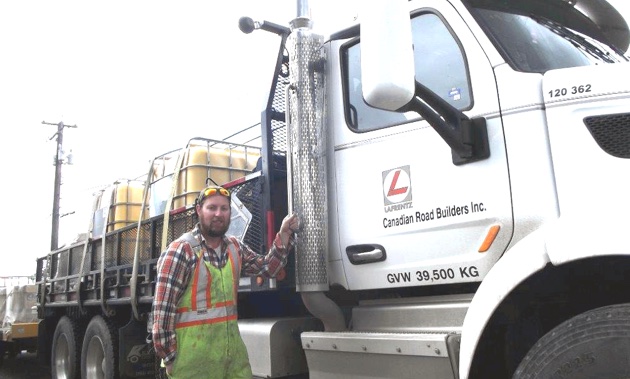More trucks on the road equal a strong economy
The British Columbian trucking industry is bigger than forestry and coal mining

Kyle Procter gets ready to board his 18-wheel Peterbilt 485 to resume working as a road marker for LaFrentz Road Marking, a division of Canadian Road Builders Inc. Procter was hauling 6,000 litres of special road marking paint. — Gerry Warner photo
“Canada’s economy moves by truck” says a headline near the top of the BC Trucking Association’s (BCTA) web page, and this claim is no less true for British Columbia or Cranbrook as endless fleets of 18- to 30-wheelers move up and down our beloved “Strip” daily.
Some may resent the thunder of truck traffic on Cranbrook Street, but no one resents the money it brings to the economy, provincially and locally, with almost 30 trucking companies located in the Key City and five major terminals.
According to Statistics Canada, in 2012 the Canadian trucking industry moved over 64 million shipments carrying 650 million tonnes of cargo and logged a total distance of 40.7 billion kilometres. B.C. has 26,000 registered trucking companies which made it a $1.8 billion industry in 2013. Trucking is bigger than forestry and coal mining in the province and employed 22,964 drivers full and part time in 2008.
The industry is hiring
A recent study concluded Canada will need 25,000 to 33,000 new, professional drivers by 2020, and the money is good, with B.C. truckers taking home an average weekly salary of $941 in 2011 including overtime, well above the provincial average of $842 weekly the same year. Most trucking companies are small, with 90 per cent operating five or fewer trucks and 59 per cent operating only one truck.
Trucking is a growth industry in the province. From 2004 to 2013, it grew by 27 per cent, an average growth rate of 2.9 per cent a year while the provincial industrial growth rate averaged 2.3 per cent over the same period. Despite this, labour shortages plague B.C.’s trucking industry as it does trucking right across Canada. In a 2013 study, the Conference Board of Canada said the trucker driver shortage will continue at least through 2020 with B.C. experiencing a 3,000 gap between demand and supply of drivers over the next five years.
Truckers are getting older too with a Conference Board of Canada study showing big rig drivers averaging 46 years compared to the national average of 41.5. In 2011, close to half (47 per cent) of B.C. professional truck drivers were between the ages of 45 and 64.
Despite this, the outlook for trucking in Cranbrook and the industry as a whole is positive according to industry representatives. Diesel prices are holding steady, freight shipments strong and rate increases are taking hold. Economic recovery in the U.S. is helping, with a three per cent growth in GDP expected in 2015 despite a first-quarter slowdown in the Canadian economy. But the economy north of the border is expected to pick up later in the year.
The industry's obstacles
“These days, our biggest obstacle is retention of drivers,” says Doug Sutherland, vice-president of Sutco Contracting Ltd., a 100 per cent family-owned company with 140 employees in B.C. Sutherland said his company offers a defined contribution pension plan matched by the company and is working hard to attract young drivers to the industry. “We have an enormous shortage of drivers and at the end of the day, it’s all about drivers.”
Other worrying factors on the horizon include more stringent greenhouse gas emission standards for the industry and the possibility that the cost of diesel (and regular gas) is expected to rise before the end of the year. Regulatory imposition of costly mandatory electronic log book devices is another concern.
But trucking has always appealed to people “who want to work and aren’t afraid of working hard,” said Ryan Chambers, vice-president of DCT Chambers Trucking Ltd., the company famous for its high-cube super-B trains regularly seen in the Kootenays. Chambers says he’s “cautiously optimistic” about the future of the industry as long as truckers can be nimble and keep their costs down.
The "BC on the Move" plan released in March by the Ministry of Transportation and Infrastructure has won praise from truckers. The plan "gets it right for the industry," said BCTA President and CEO Louise Yako and is an indication the government recognizes "a strong and healthy B.C. economy relies heavily on a vibrant, thriving and efficient trucking industry."





Comments